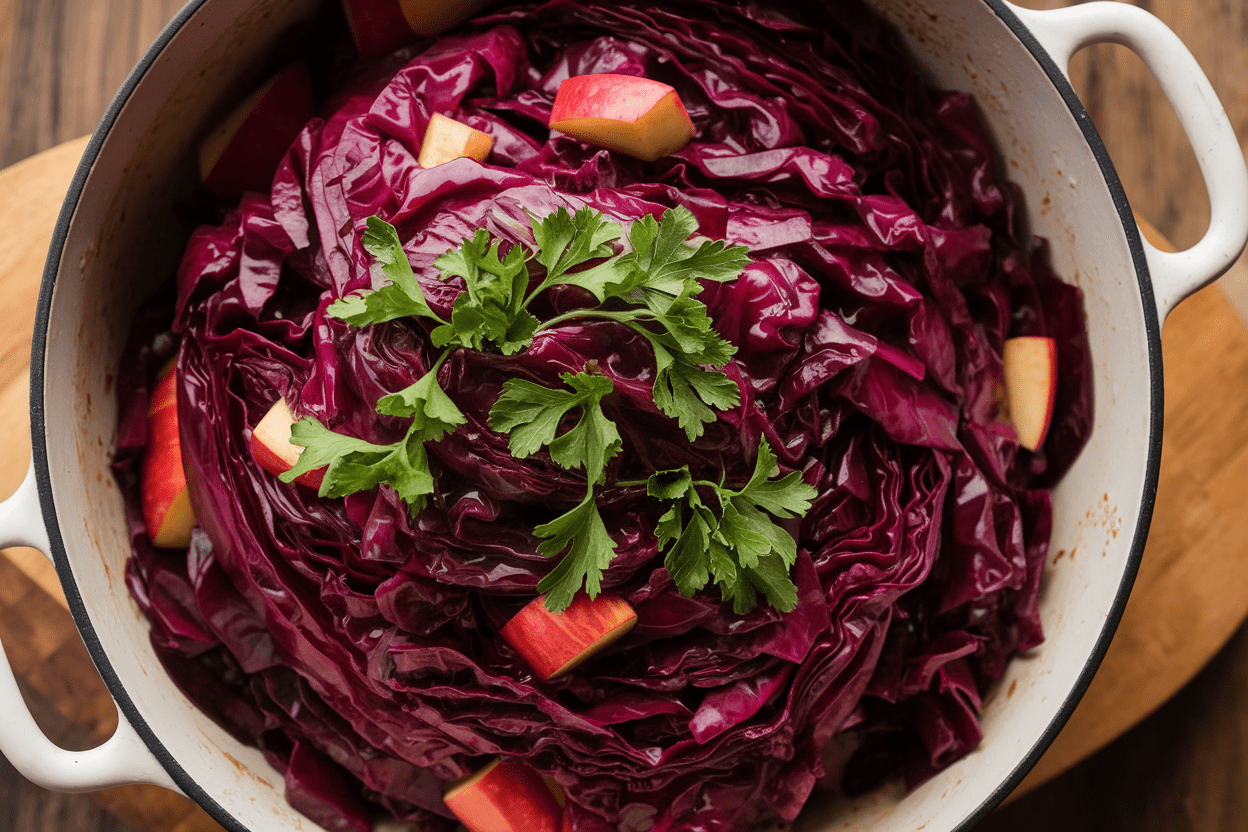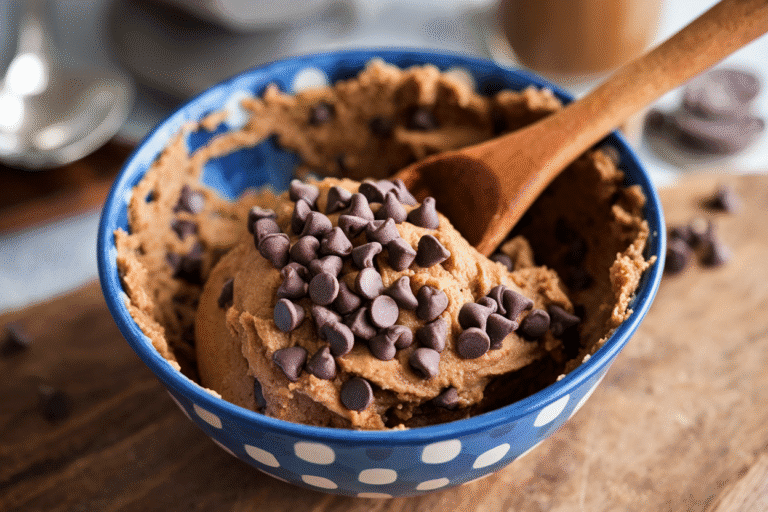German Red Cabbage Recipe That Slaps: Sweet, Savory, and Shockingly Simple
You want a side that makes everything else on the plate taste better? This is it. German red cabbage is the unsung hero that turns weeknight sausages into a feast and holiday roasts into events.
It’s tangy, a little sweet, totally cozy, and ridiculously easy to master. You don’t need a Michelin star—just a pot, a head of cabbage, and the patience to let it get glossy and tender. It’s budget-friendly, make-ahead friendly, and yes, picky-eater friendly.
What more do you want—a parade?
What Makes This Special
This dish—called Rotkohl or Blaukraut in Germany—is the definition of comfort with a backbone. It balances sweet, sour, and savory in one pot, thanks to apples, vinegar, and warm spices. The slow braise lets the cabbage become silky while keeping just enough bite to feel satisfying, not mushy.
It’s a classic for a reason: it pairs with everything from pork chops to roast duck, and it can carry a vegetarian dinner with potatoes like a champ.
Bonus: it’s a flavor sponge. Make it today, and it tastes great. Make it tomorrow, and it tastes better.
The acids and spices settle in, and suddenly you’re canceling dinner plans to stay in with a bowl of cabbage. Relatable?
What Goes Into This Recipe – Ingredients
- 1 medium red cabbage (about 2–2.5 lb), core removed, thinly sliced
- 1 large onion, thinly sliced
- 2 medium tart apples (Granny Smith or Braeburn), peeled and sliced
- 3 tbsp butter (or neutral oil for dairy-free)
- 1/3 cup apple cider vinegar (or red wine vinegar)
- 1/3–1/2 cup water or low-sodium stock
- 2–3 tbsp brown sugar (adjust to taste)
- 1 tsp kosher salt, plus more to taste
- 1/2 tsp black pepper
- 1/2 tsp ground allspice (or 3 whole allspice berries)
- 1 small cinnamon stick (or 1/4 tsp ground)
- 2 whole cloves (or a small pinch ground)
- 1 bay leaf
- Optional: 2 tbsp red currant jelly or cranberry sauce for gloss and depth
- Optional: 2–3 slices bacon, chopped, for a savory boost
- Optional finish: 1–2 tsp lemon juice or more vinegar for brightness
Step-by-Step Instructions
- Prep like a pro. Remove the tough outer leaves of the cabbage. Quarter it, core it, then slice thinly.
Slice the onion and apples. Keep everything uniform for even cooking.
- Start the base. In a large Dutch oven, melt the butter over medium heat. If using bacon, cook it first until crisp, then remove and leave the fat in the pot.
Add the onion and a pinch of salt. Cook 5–7 minutes until soft and slightly golden.
- Bloom the spices. Add cinnamon stick, bay leaf, allspice, and cloves. Stir for 30 seconds.
Your kitchen should smell like a holiday market.
- Add cabbage and apples. Pile them in. It will look like too much. It isn’t.
Toss with tongs until the cabbage starts to wilt, about 3–4 minutes.
- Build the sauce. Stir in vinegar, water/stock, brown sugar, salt, and pepper. If using jelly, add it now. Bring to a gentle simmer.
- Braise low and slow. Cover and simmer on low for 45–60 minutes, stirring every 10–15 minutes.
Add a splash more water if the pot gets dry. You want tender ribbons with a slight bite, not mush.
- Taste and tune. Remove the bay leaf and whole spices. Adjust sweetness and acidity: add a teaspoon of sugar if too sharp, or a splash of vinegar/lemon if too sweet.
Salt to taste. Fold in the bacon if using.
- Rest (optional but powerful). Let it sit 10–15 minutes off heat to mellow. FYI, it’s even better the next day.
- Serve. Spoon alongside roast meats, sausages, potato dumplings, or a creamy mash.
The color pop alone is worth it.
Storage Instructions
- Fridge: Store in an airtight container for 4–5 days. Flavor improves on day two.
- Freezer: Freeze up to 3 months. Cool completely, portion, and freeze.
Thaw overnight in the fridge.
- Reheat: Warm gently on the stove with a splash of water or stock. Brighten with a dash of vinegar if needed after reheating.
Health Benefits
- Antioxidant power: Red cabbage is packed with anthocyanins, the same compounds that make blueberries “super.” They support heart and brain health.
- Vitamin boost: High in vitamins C and K, plus fiber for gut health and satiety. Translation: filling without the food coma.
- Lower sugar than you think: The sweetness is adjustable.
You control the sugar, not the label.
- Healthy fats (if you choose): Butter adds fat-soluble vitamin absorption and flavor. Use olive oil for a lighter spin.
Common Mistakes to Avoid
- Too much heat: Boiling aggressively breaks the cabbage down into a colorless slump. Keep it low and slow.
- Skipping acid: Vinegar isn’t optional—it sets the color and balances sweetness.
Without it, the dish tastes flat and looks dull.
- Over-sweetening early: Sugar concentrates as liquid reduces. Start modest, adjust at the end.
- Not stirring: Cabbage at the bottom can scorch. Stir every 10–15 minutes to prevent bitter spots.
- Using pre-shredded slaw mix: It’s too thin and wilts into nothing.
Slice a fresh head for ideal texture.
Variations You Can Try
- Wine-kissed: Replace half the water with dry red wine for a deeper, dinner-party vibe.
- Smoky bacon: Start with diced bacon or speck and use the drippings as your fat. Instant umami.
- Vegan glossy: Skip butter and bacon; add 1 tbsp olive oil plus a spoon of red currant jelly for sheen and body.
- Caraway crunch: Add 1/2 tsp caraway seeds with the spices for a classic German note.
- Cran-apple holiday: Stir in a handful of dried cranberries in the last 10 minutes for tart pops.
- Spiced heat: A pinch of chili flakes adds warmth that sneaks up—great with sausages.
- Orange zest: Finish with 1/2 tsp orange zest for brightness that plays nice with pork and duck.
FAQ
Can I make this ahead for a party?
Absolutely. This is a make-ahead MVP.
Cook up to 2 days in advance, chill, and reheat gently. The flavor actually improves as it rests.
What can I serve it with?
Classics include bratwurst, roast pork, duck, schnitzel, and holiday roasts. It’s also awesome with mashed potatoes, spaetzle, or a hearty lentil loaf if you’re going plant-based.
Do I need the apples?
They’re traditional and add natural sweetness and body.
If you skip them, increase the sugar slightly or add a spoon of jelly for balance.
Why did my cabbage turn blue?
Red cabbage is pH-sensitive. If the dish skews basic (not enough acid), it turns bluish. Add more vinegar or lemon juice to restore that vibrant magenta.
How do I keep it from getting mushy?
Slice the cabbage not paper-thin, simmer gently, and stop cooking when it’s tender with a slight bite.
Overcooking is the fast track to mush city, IMO.
Can I use white cabbage instead?
You can, but it won’t be the same dish. White cabbage lacks the tangy color magic and distinct flavor. If you must, increase vinegar and spices to compensate.
Is this gluten-free?
Yes, as written.
Just ensure your stock (if using) is gluten-free. Most vinegars are fine, but double-check labels for flavored varieties.
Can I reduce the sugar?
Totally. Start with 1 tablespoon and adjust at the end.
You can also lean on apple sweetness or swap in a sugar-free sweetener you like.
My Take
This German red cabbage recipe is the side dish that behaves like a main character. It’s minimal effort for maximum payoff, friendly to leftovers, and flexible enough to dress up or down depending on your mood. If you keep one comfort-food ace up your sleeve for fall and winter, make it this one.
It’s the little pot of tangy, glossy, ruby comfort you didn’t know you needed—until now.






